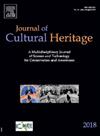Tracing the evolution of artists' materials and manufacturers' choices in painted magic lantern slides
IF 3.3
2区 综合性期刊
0 ARCHAEOLOGY
引用次数: 0
Abstract
Painted glass slides are fragile miniatures painted by hand on flat glass support to be projected with magic lanterns. Following the development of the magic lantern as the first optical instrument of projection in the mid-17th century, painted glass slides achieved the apogee of their production and use during the 18th and 19th centuries. Despite their widespread presence in collections and museums worldwide, the study of their materiality remains underexplored, posing challenges to their preservation.
This work investigates the colourants and binders used in 42 slides from Portuguese collections (Portuguese Cinematheque – Museum of Cinema and National Museum of Natural History and Science of the University of Lisbon) representative of the European production of the 18th and 19th centuries. A multi-analytical approach was employed, with minimal sampling restricted to paint areas detaching from the glass. Energy-dispersive X-ray fluorescence (EDXRF) spectrometry, Ultraviolet-Visible (UV–VIS) and Raman spectroscopies were favoured for in situ analysis, complemented by Fourier-transform infrared spectroscopy (FTIR) and Surface-Enhanced Raman spectroscopy (SERS) carried out on micro-samples. It was possible to detect the presence of mastic and shellac resins as binding components and to identify several colourants, including red ochre, cochineal-based lakes, geranium lakes, vermilion, yellow ochre, gamboge, Prussian blue, ultramarine blue, copper-green, and carbon-black, and fillers such as gypsum.
These results establish correlations between identified materials and historical sources, reflecting artists’ choices and evolving manufacturing practices. Distinct palettes and techniques were associated with manufacturers such as Philip Carpenter, Carpenter & Westley, W.E. & F. Newton, and Lapierre. The findings contribute to a deeper understanding of slide production techniques and support improved conservation strategies for these delicate and often overlooked heritage objects.

在彩绘魔幻幻灯幻灯片中,追溯艺术家材料和制造商选择的演变
彩绘玻璃滑梯是一种易碎的微缩模型,由手工绘制在平板玻璃支架上,用魔灯投射。继17世纪中叶魔术灯作为第一种光学投影工具的发展之后,彩色玻璃玻片在18世纪和19世纪达到了它们的生产和使用的顶峰。尽管它们在世界各地的收藏品和博物馆中广泛存在,但对其物质的研究仍未得到充分探索,这给它们的保存带来了挑战。本作品调查了来自葡萄牙收藏(葡萄牙电影博物馆和里斯本大学国家自然历史和科学博物馆)的42张幻灯片中使用的着色剂和粘合剂,这些幻灯片代表了18世纪和19世纪欧洲的生产。采用了一种多分析方法,最小的采样仅限于从玻璃分离的油漆区域。原位分析采用能量色散x射线荧光(EDXRF)光谱法、紫外-可见(UV-VIS)光谱法和拉曼光谱法,显微样品采用傅里叶变换红外光谱法(FTIR)和表面增强拉曼光谱法(SERS)。有可能检测到乳胶漆和紫胶树脂作为粘合成分的存在,并识别出几种着色剂,包括红赭石、胭脂胭脂、天竺葵、朱砂、黄赭石、藤黄、普鲁士蓝、深蓝色、铜绿和炭黑,以及石膏等填料。这些结果建立了确定的材料和历史来源之间的相关性,反映了艺术家的选择和不断发展的制造实践。独特的调色板和技术与Philip Carpenter, Carpenter &;威斯利,W.E. &;牛顿和拉皮埃尔。这些发现有助于更深入地了解幻灯片制作技术,并支持改进这些脆弱且经常被忽视的遗产物品的保护策略。
本文章由计算机程序翻译,如有差异,请以英文原文为准。
求助全文
约1分钟内获得全文
求助全文
来源期刊

Journal of Cultural Heritage
综合性期刊-材料科学:综合
CiteScore
6.80
自引率
9.70%
发文量
166
审稿时长
52 days
期刊介绍:
The Journal of Cultural Heritage publishes original papers which comprise previously unpublished data and present innovative methods concerning all aspects of science and technology of cultural heritage as well as interpretation and theoretical issues related to preservation.
 求助内容:
求助内容: 应助结果提醒方式:
应助结果提醒方式:


